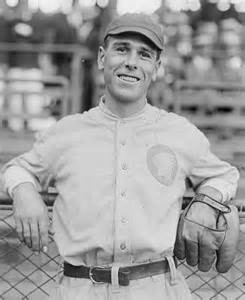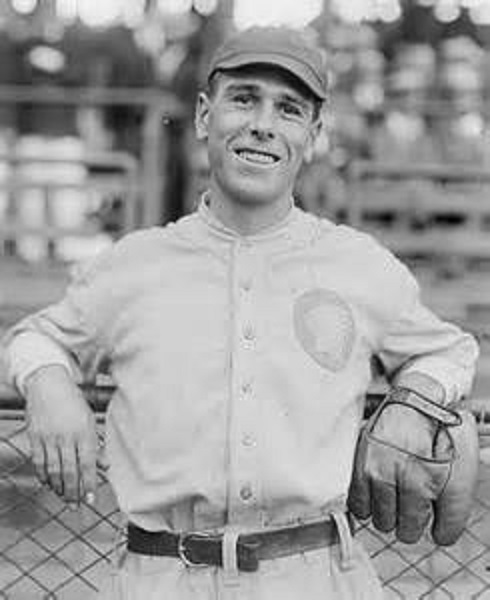Subscribe to my blog for automatic updates and as a Free Bonus get instant access to my two embedded E-Books: “Memorable World Series Moments,” and “Gary’s Handy Dandy World Series Reference Guide!”
1912 World Series Photo Gallery
Click on any image below to view entire gallery:

The 1912 World Series and the Fred Snodgrass $30,000 Muff
We all hear a lot about the infamous Merkle game in 1908, but not quite as much about another incident, the Fred Snodgrass “$30,000 Muff” which occurred during the 1912 World Series between John McGraw’s Giants and the Boston Red Sox. Like Merkle in 1908, Snodgrass was considered the “goat” and the newspapers of the time blamed him for the Giants’ World Series loss. This unfortunate occurrence also had a “Merkle connection,” as you’ll see when you read the story.
The World Series was played in Boston that year. The incident happened in the tenth inning of the eighth and last game of the Series. The score was tied 1-1 after nine innings, but the Giants scored a run in the top of the tenth to take the lead and were three outs away from a World Series Championship. Having lost the World Series in 1911 to the Philadelphia Athletics, they were just about ready to celebrate.
And then it happened…
The first batter up in the bottom of the tenth, Clyde Engel hit a routine fly ball to center fielder Snodgrass, who was known as one of the best outfielders of the Dead Ball Era. Snodgrass just flat out dropped the darned ball! A ball that he normally puts in his hip pocket. I’ll let Snodgrass pick up the story from here. As you’ll see, he gets quite defensive about the so-called “Snodgrass Muff”:
“I never lost that World Series. I never took the blame for losing any World Series…I did drop the ball. There’s no question about that. But I didn’t let the tying and winning runs score. I couldn’t very well because it happened with the first batter! In the top of the tenth, we scored – on a hit by Fred Merkle by the way –and went into the bottom of the tenth with Matty pitching and a one-run lead. If we could have held that one-run lead, we would have won the World Series.”
“The ball was hit so high that Engel was standing on second before I could get the ball back to the infield. Well, Harry Hooper was the next batter. And in the 10th inning of a tie game, the last game of a World Series, we were just certain he would bunt to move the man over to third. But instead of bunting, Hooper cracked a drive way over my head. I made one of the greatest plays of my life on it, catching the ball over my shoulder while on the dead run out in deep left center. They always forget about that play when they write about that inning. So that’s one out. Then Matty walked Steve Yerkes, unfortunately, with what proved to be the winning run. Two men on and only one out. And up comes Tris Speaker, one of the greatest hitters in the game.”
“What does Speaker do but take a swing at the ball and hit a nice easy pop-up, a foul ball, over near first base. And that ball was never touched! Merkle didn’t have to go thirty feet to get it, it was almost in the first-base coaching box. Chief Meyers, our catcher, tried to catch it, but couldn’t quite get there. It was too far from home plate. Matty could have put it in his hind pocket. But no one ever touched it. Well, given that reprieve, Speaker hit a clean line drive over the first baseman’s head that scored the man I put on and put Yerkes on third base. Another long fly to right by Larry Gardner and Yerkes scored after the catch. The game is over and, according to the newspapers, Fred Snodgrass lost the World Series. However, the facts don’t seem to matter.”
Giants’ manager John McGraw was not among those who blamed Snodgrass for the loss. In his book My Thirty Years in the Game, McGraw remarked, “Often I have been asked what I did to Fred Snodgrass after he dropped that fly ball in the World Series of 1912…I will tell you exactly what I did: I raised his salary $1,000.”
Fred Snodgrass played eight years in the Major Leagues with the Giants and Braves. He hit .275 with 215 stolen bases and 453 RBIs. He played in the World Series with the Giants in 1911, 1912, and 1913, although the Giants lost all three. Career highlights include a .440 on-base percentage in 1910 (second in the league), 51 stolen bases in 1911 (third in the League), and 48 stolen bases in 1912 (third in the League). Snodgrass later became a successful banker and was a popular city council man and mayor in Oxnard, California, the largest city in his native Ventura County. His error in the 1912 World Series remained with him to the end. When he died on April 5, 1974, his obituary in the New York Times was headlined “Fred Snodgrass, 86, Dead; Ball Player Muffed 1912 Fly.”
-Gary Livacari
Thanks for reading my post. Hope you enjoyed it! Before you leave, I hope you’ll consider:
-Viewing the other posts in my blog. Click “Home” icon on left to see display of other posts.
-Following me on any one of my social networks.
-Sharing to your favorite social media
-Leaving a comment…I love interacting with my readers!
-Subscribing for automatic updates and Free Bonus: “Memorable World Series Moments” and “Gary’s Handy Dandy World Series Reference Guide.”
Photo Credits: All from public domain
Information: Excerpts edited from the 1912 World Series Wikipedia page; and The Glory of Their Times, by Lawrence Ritter.
Click “Home” icon on left to see display of all articles. Follow us on Twitter: @Livac2
Visit our Facebook page: Old-Time Baseball Photos

